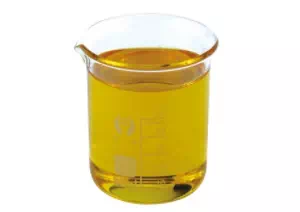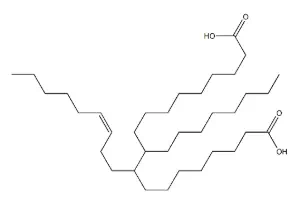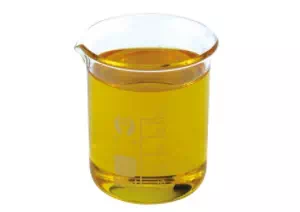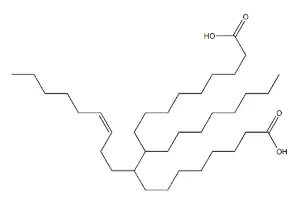All Categories



C36 Dimer acid CAS 61788-89-4 C36H64O4
Dimer acid is an important industrial chemical, mainly a dimer formed by thermal polymerization or catalytic polymerization of unsaturated fatty acids (such as oleic acid and linoleic acid). Its chemical structure and reactivity make it widely used in many fields, mostly used to prepare high-performance coatings and lubricant additives.
CAS : 61788-89-4
Formula : C36H64O4
Mol. wt. : 560.91
EINECS : 500-148-0
| CAS | 61788-89-4 |
| Molecular formula | C36H64O4 |
| Molecular weight | 560.91 |
| EIENCS | 500-148-0 |
| Form | Liquid |
| Melting point | / |
| boling point | / |
| Density | / |
| Solubility | / |
| PKA | / |
| Color | Light yellow or yellow green liquid |
| Storage temp | / |
Structural features:
Contains two carboxyl groups (-COOH) and a long-chain aliphatic hydrocarbon structure, usually C36 dicarboxylic acid.
The molecular chain contains branches, cyclic structures (such as cyclohexene) and a small amount of unreacted monoacids and trimer acids.
The hydrophobic carbon chain provides flexibility, and the polar carboxyl group imparts reactivity.
Main chemical properties:
Acidity: It has the typical properties of carboxylic acids and can form derivatives such as salts, esters, and amides.
Reactivity:
Reacts with amines to form polyamide resins (the core raw material of epoxy curing agents).
Esterification with alcohols to form dimer acid esters (lubricant additives, plasticizers).
Reacts with epoxy compounds (such as ethylene oxide) to form surfactants.
Thermal stability: not easy to decompose at high temperature (decomposition temperature>250℃), suitable for high temperature process.
Low volatility: large molecular weight, low vapor pressure, reducing volatilization loss during use.
(1) Polyamide curing agent (indirect catalytic epoxy resin curing)
Mechanism of action:
Dimer acid and polyamine (such as ethylenediamine and diethylenetriamine) are condensed to form polyamide resin. The amino group (-NH₂) of the resin acts as a nucleophilic reagent to catalyze the ring-opening polymerization of the epoxy group to achieve room temperature curing of the epoxy resin.
Advantages:
Low toxicity and low volatility (compared with traditional amine curing agents).
It gives the cured product high toughness, impact resistance and adhesion.
Application scenarios:
Ship coatings, industrial floor paints, adhesives, composite materials (such as wind turbine blades).
(2) Lubricant additives (auxiliaries)
Function:
Dimer acid esters (such as esterified with pentaerythritol) are used as extreme pressure anti-wear agents and oiliness agents.
Mechanism of action:
Polar carboxyl groups adsorb on the metal surface to form a protective film, reducing friction and wear.
Long carbon chains provide lubricity and reduce viscosity loss at high temperatures.
Application areas:
Metalworking fluids, gear oils, engine oils, bio-based lubricants.
(3) Surfactant synthesis (catalytic reaction additives)
Use:
Dimer acid reacts with ethylene oxide/propylene oxide to form block polyether surfactants.
Characteristics:
It has both hydrophobic chains and hydrophilic polyether chains to reduce interfacial tension.
Used as emulsifiers and dispersants (such as pesticide formulations and pigment dispersions).
(4) Polymer modification additives
Plasticizers:
Dimer acid esters (such as octyl esters) replace phthalates and are used in PVC and rubber to improve low-temperature flexibility.
Rheology modifier:
Adjust the leveling properties in inks and coatings to prevent pigment sedimentation.

Toxicity: Dimer acid is not generally considered a hazardous chemical, but it may be potentially dangerous under certain conditions (such as high temperature, high pressure or when mixed with other chemicals). Therefore, appropriate safety measures should be taken when handling dimer acid, such as wearing personal protective equipment such as protective glasses and gloves, and following relevant operating procedures.
Storage and transportation: During storage and transportation, it should be kept low temperature, dry and ventilated, and avoid direct sunlight. At the same time, it should be avoided from being mixed with flammable and explosive items.
Environmental protection: The production and use of dimer acid may cause certain environmental pollution. Therefore, effective environmental protection measures should be taken to reduce the discharge of wastewater, waste gas and solid waste and protect the ecological environment.
* Prompt reply and 24 hours online, professional team to provide best price and high quality product.
* Sample testing support.
* Every batch of products will be tested to ensureits quality.
*The packing also can be according the customers` requirment.
*Any inquiries will be replied within 24 hours.
*we provide Commerical Invoice, Packing List, Bill of loading, COA , Health certificate and Origin certificate. If your markets have any special requirements, let us know.